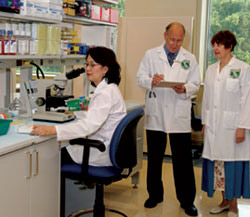 |
 |
 |
 Health & Beauty | June 2005 Health & Beauty | June 2005  
Looking for Cures
 Teresa Gordon - Hispanic Magazine Teresa Gordon - Hispanic Magazine


| | Hispanics urged to participate in clinical trials. |
Imagine being told by your doctor that because of a serious medical condition you have only months to live. A frightening prospect certainly, and one that calls for a second opinion as part of your plan of action. But perhaps an even more promising, fight-back alternative might be to contact the National Institutes of Health Clinical Center in Bethesda, Maryland, the largest hospital in the world dedicated to clinical research. For more than five decades, the NIH has served thousands of patients with a diverse range of diseases and conditions, many of whom are alive today because of their participation in clinical trials there.

Targeting more Hispanics to participate is a goal of the NIH’s new research hospital, opened last fall. Researchers at the NIH Clinical Center are seeking treatments for diseases such as diabetes, high blood pressure, lupus, and certain cancers. In the past, the clinical center’s research has produced such breakthroughs as the first cure of a tumor with chemotherapy, the first cure of childhood leukemia and Hodgkin’s disease with chemotherapy, and the first use of AZT to treat AIDS.

“It is so important to include more Latinos in clinical research,” says Dinora Domínguez, a registered nurse and a patient recruiter in the NIH Clinical Center’s patient recruitment office. “We need everyone who makes up our community so that our information is representative. We can’t exclude ourselves.”

A clinical trial is a research study using patient and healthy volunteers to answer certain health questions. Volunteers are admitted as part of a specific fit for a trial that includes age, gender and type, and stage of their medical conditions. At no charge, volunteers are treated at the hospital by a team of doctors, nurses, and social workers and gain access to new treatments before they are widely available.

On average the NIH Clinical Center sees approximately 20,000 patients a year, of which about 5 percent are self-identified as Hispanics.

“At any one time, there are over 1,000 studies going on,” says Domínguez. “I think the reason more Latinos have not participated in the past is just not knowing about it. There is no translation for the term, ‘clinical trial,’ for instance.”

Domínguez, herself a native of the Dominican Republic and a nursing graduate of the University of Rhode Island, travels across the United States to get the word out by appearing at health fairs and on Spanish-language radio programs. She says that the NIH has increased the number of translators at the clinical center to ease the language barrier for Hispanic patients.

“Even our food diaries will be different, with our tortillas, refried beans, and pupusas. That is important information for research,” she says. “Eating plantains three times a day for a Dominican family, how could you not include that?”

Narcisa Castro, from Ecuador, is one patient who has benefited from participating. The 39-year-old secretary and mother of two boys suffered from severe nausea and headaches that baffled her local doctors. Finally, a local hematologist diagnosed her condition as CML, chronic mylogenous leukemia, and referred her to the NIH.

Traveling with her husband and brother to the NIH Clinical Center, Castro says that instead of a cold, impersonal hospital environment, she was met with “mucho cariño y sonrisas” by its warm staff. She was placed in a blood and bone marrow transplant program, and, in the past six months, her condition has improved greatly.

“My family has accepted the process,” says Castro, who adds that she has enjoyed making friends among fellow patients of different Latino backgrounds, including Salvadorans, Puerto Ricans, and Hondurans.

“We have very good connections with hematologists in Central and South America,” says Dr. Neal Young, chief of the Hematology Research Branch at NIH’s National Heart, Lung, and Blood Institute, the sponsoring research institute whose research program treats Castro.

“Through the grafting of [blood] stem cells, we can not only kill tumors, but alter the immune system as well.”

Domínguez urges participants to check with their health-care providers to learn more about participating at the NIH Clinical Center. “Besides helping ourselves, we know what we’re doing today is affecting many people for the future,” she says. | 
 | |
 |



